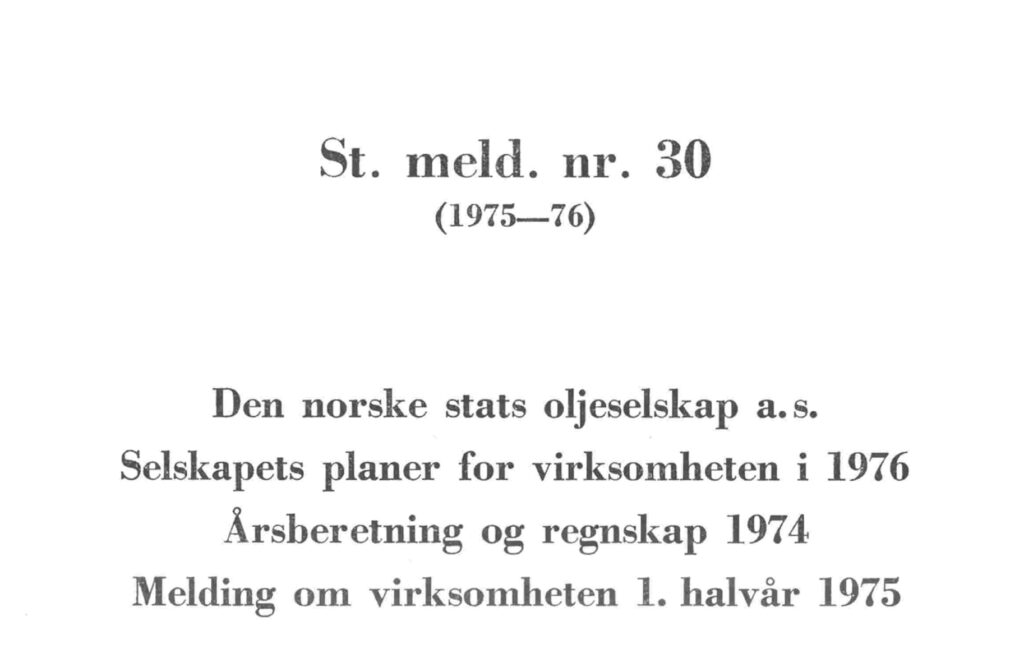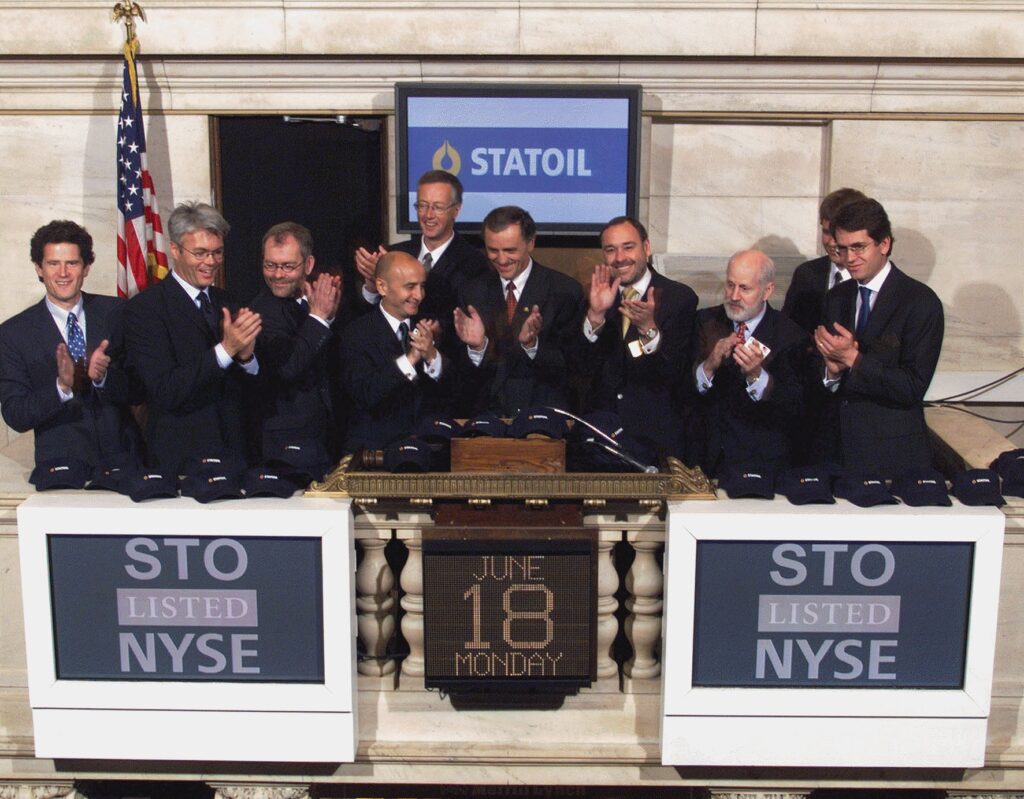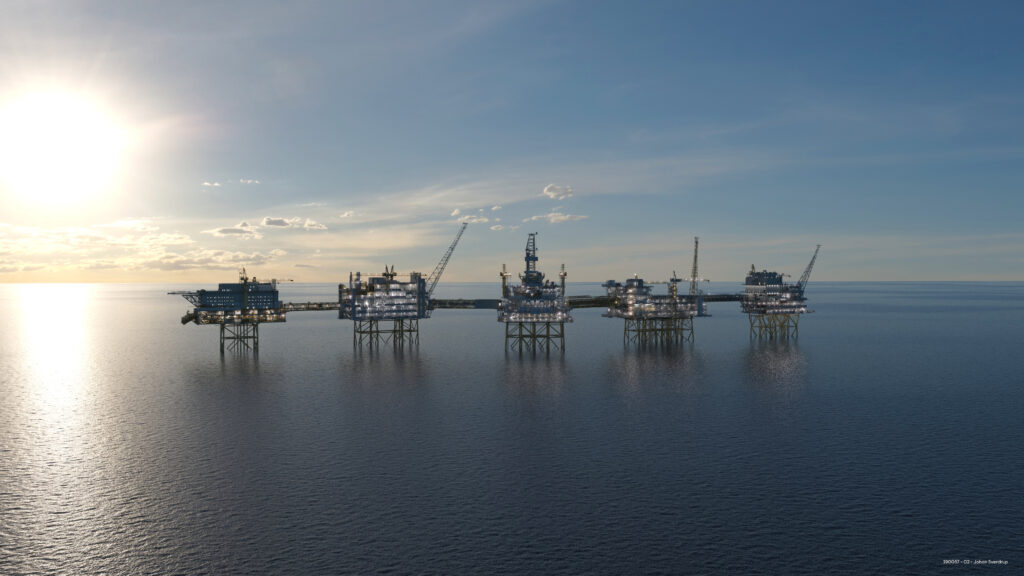Equinor’s company history in brief

Norway’s state oil company was established by a unanimous vote of the Storting (parliament) on 14 June 1979. The Ministry of Industry and Handicraft – and later the Ministry of Petroleum and Energy – exercised the powers of sole owner on behalf of the state. The company’s head office was placed in Stavanger.[REMOVE]Fotnote: This article builds on the https://nsd.no/polsys/data/forvaltning/enhet/52950/endringshistorie website, which was accessed in January 2020 but is no longer available.
Articles of association and structure
The political motivation for creating the company was a desire for Norwegian participation in offshore operations from the start in order to build up expertise which could form the basis for a national oil industry. Its object clause specified that Statoil would “either by itself or through participation in or together with other companies … carry out exploration for and production, transport, processing and marketing of petroleum and petroleum-derived products”.
Statoil’s articles of association were not approved by the Storting until March 1974. They included a requirement for the board to discuss key issues with the industry minister (later the petroleum and energy minister). The Storting decided that the government would present an annual statement of Statoil’s plans and projects, with financial overviews and information on other significant matters of principle or issues of political importance.

As early as 1973, Statoil launched efforts to become involved in petrochemicals. After lobbying and acquisitions, the company secured full control of the Rafnes plant in Bamble south of Oslo as well as joint ownership of the Mongstad refinery with Norsk Hydro.
Modernisation plans for the latter facility, soon initiated by Statoil, eventually prompted Hydro to sell out of the plant to the state company. That left it solely responsible for the upgrading.
Statoil quickly became Norway’s largest oil company. Its first licence interest was in the Statfjord field, which came on stream in 1979. The company was the first Norwegian player to obtain operator responsibility, on the Gullfaks field in 1981, and it took over the Statfjord operatorship in 1987.
The company also made a commitment to selling petroleum products, and incorporated Norsk Olje A/S (Norol) from 1 January 1980.
SDFI
The state’s direct financial interest (SDFI) in Norwegian petroleum operations was introduced in 1985 with the aim of reducing Statoil’s size to some extent. That involved dividing its equity interests in most production licences into two parts, one retained by Statoil and the other taken over directly by the state. The latter thereby gained a direct interest in most of the oil and gas fields on the Norwegian continental shelf (NCS). This solution did not affect operatorships, and Statoil served as the commercial manager of the SDFI with responsibility for all petroleum sales.
Comprising a substantial slice of Norway’s petroleum activities, the SDFI accounted in 2000 for just over 40 per cent of total investment on the NCS. In that year, it yielded about NOK 100 billion to the Treasury.[REMOVE]Fotnote: http://www.snl.no/SDØE.
Partial privatisation

The company secured a stock exchange listing on 18 June 2001 and changed its name to Statoil ASA. From then on, it was partially privatised with the Norwegian state as the majority shareholder – initially at 81.7 per cent.[REMOVE]Fotnote: Saksnummer Stortinget sakid=(20602) Saksnummer Stortinget sakid=(21571). The Storting approved the sale of shares equivalent to 15-25 per cent of Statoil’s value.[REMOVE]Fotnote: Proposition no 68 (2000-2001) to the Storting, Budsjettkonsekvensar for 2001 knytta til gjennomføring av tilrådde tiltak i St.prp.nr. 36 (2000-2001) Eierskap i Statoil og fremtidig forvaltning av SDØE; Appendix to proposition 36 (2000-2001) to the Storting, Eierskap i Statoil og fremtidig forvalting av SDØE; Proposition 36 (2000-2001) to the Storting, Eierskap i Statoil og fremtidig forvalting av SDØE; Recommendation no 198 (2000-2001) to the Storting, Eierskap i Statoil og fremtidig forvaltning av SDØE.
As part of the same reform, two new state-owned companies were established – Petoro to manage the SDFI and Gassco to operate the Norwegian gas transport system.
On 6 July 2004, the state holding in Statoil ASA was further reduced when the Ministry of Petroleum and Energy disposed of 100 million shares through a “block sale” after the Oslo Stock Exchange had closed. This raised NOK 9.9 billion and left the state with a 77.1 per cent holding.[REMOVE]Fotnote: Press release 80/04, Ministry of Petroleum and Energy.
Another sale to investors and almost 20 000 private individuals on 25 February 2005 brought the state’s shareholding down to 70.9 per cent.[REMOVE]Fotnote: Press release 30/05, Ministry of Petroleum and Energy.
Hydro merger

The boards of Statoil ASA and Norsk Hydro ASA announced on 18 December 2006 that they had agreed to recommend a merger between Hydro’s oil and energy division and Statoil to their shareholders.[REMOVE]Fotnote: Saksnummer Stortinget sakid=(36997).
This transaction was implemented on 1 October 2007. At the same time, the company changed its name to StatoilHydro. The state’s stake had then fallen to 62.5 per cent.[REMOVE]Fotnote: http://www.regjeringen.no/nb/dep/oed/dok/regpubl/stprp/20062007/Stprp-nr-60-2006-2007-.html?id=461986. On 2 November 2009, the company name reverted to Statoil ASA.[REMOVE]Fotnote: Saksnummer Stortinget sakid=(49302); https://www.equinor.com/news/archive/2009/11/02/02NovStatoilHydroBecomesStatoil
As a result of the merger, Statoil’s organisational structure was amended with effect from 1 January 2011 to reflect the company’s increased involvement in the USA in particular and internationally in general. Seven business areas were established:[REMOVE]Fotnote: Report no 13 (2010-2011) to the Storting, Aktivt eierskap: 95.
- development and production Norway, responsible for upstream activities on the NCS
- development and production North America, responsible for all upstream activities in the USA and Canada
- development and production international, responsible for all other upstream activities
- marketing, processing and renewable energy, responsible for oil and gas trading, onshore plants, and developing and operating renewable energy
- technology, projects and drilling, responsible for technology development, planning and execution of projects, and drilling activities
- exploration, responsible for all exploration activities in close collaboration with the three upstream areas
- global strategy and business development, responsible for developing strategy and coordinating business development.
From oil and gas to energy

A proposal by the board on 15 March 2018 that Statoil should change its name to Equinor was approved by the annual general meeting on 15 May 2018 and adopted with effect from 16 May. This renaming was intended to reflect the company’s transition from a primary involvement with oil and gas into a broad energy company.[REMOVE]Fotnote: https://www.equinor.com/
The state holds 67 per cent of the shares in Equinor through the Ministry of Petroleum and Energy.
According to the report on state ownership for 2018, Equinor ASA is an international technology-based energy company with oil and gas production as its main activity. It also has downstream operations and activities in renewable energy – including solar and offshore wind power. At 2018, Equinor had operations in more than 30 countries and ranked among the world’s largest net sellers of crude oil and condensate. In addition, the company was one of the biggest suppliers of natural gas to the European market. At 31 December 2018, it had about 20 500 employees.

Equinor is still listed on the Oslo and New York stock exchanges, and its head office remains in Stavanger. The object of the state’s ownership is for the company to be operated on a commercial basis with the aim of delivering a competitive return. Furthermore, this ownership will contribute to maintaining a knowledge-based and high-tech industrial group with head office functions in Norway.[REMOVE]Fotnote: Statens eierberetning 2018: 52.
arrow_backFive decades as an oil and energy cityEquinor at 50arrow_forward